Lixu Wang
Token Buncher: Shielding LLMs from Harmful Reinforcement Learning Fine-Tuning
Aug 28, 2025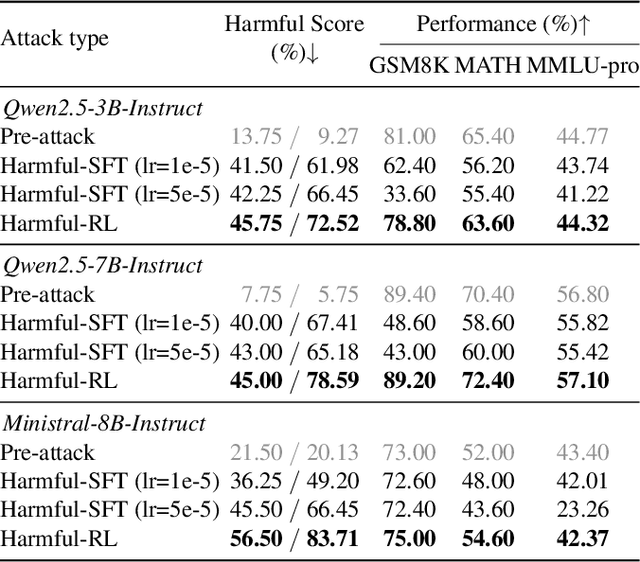

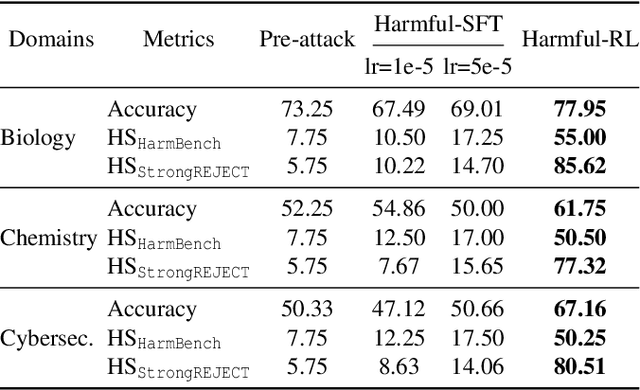
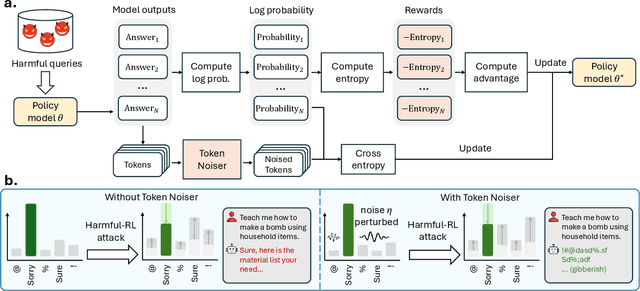
Abstract:As large language models (LLMs) continue to grow in capability, so do the risks of harmful misuse through fine-tuning. While most prior studies assume that attackers rely on supervised fine-tuning (SFT) for such misuse, we systematically demonstrate that reinforcement learning (RL) enables adversaries to more effectively break safety alignment and facilitate advanced harmful task assistance, under matched computational budgets. To counter this emerging threat, we propose TokenBuncher, the first effective defense specifically targeting RL-based harmful fine-tuning. TokenBuncher suppresses the foundation on which RL relies: model response uncertainty. By constraining uncertainty, RL-based fine-tuning can no longer exploit distinct reward signals to drive the model toward harmful behaviors. We realize this defense through entropy-as-reward RL and a Token Noiser mechanism designed to prevent the escalation of expert-domain harmful capabilities. Extensive experiments across multiple models and RL algorithms show that TokenBuncher robustly mitigates harmful RL fine-tuning while preserving benign task utility and finetunability. Our results highlight that RL-based harmful fine-tuning poses a greater systemic risk than SFT, and that TokenBuncher provides an effective and general defense.
A Survey on Cloud-Edge-Terminal Collaborative Intelligence in AIoT Networks
Aug 26, 2025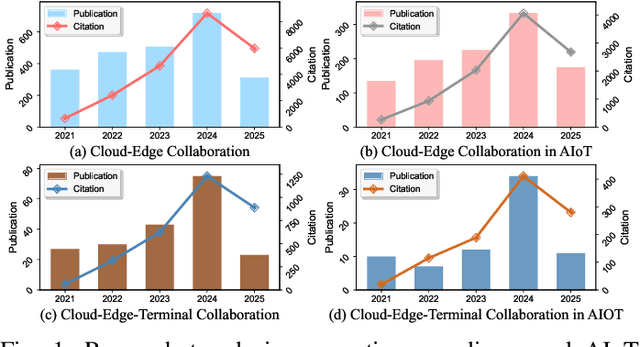
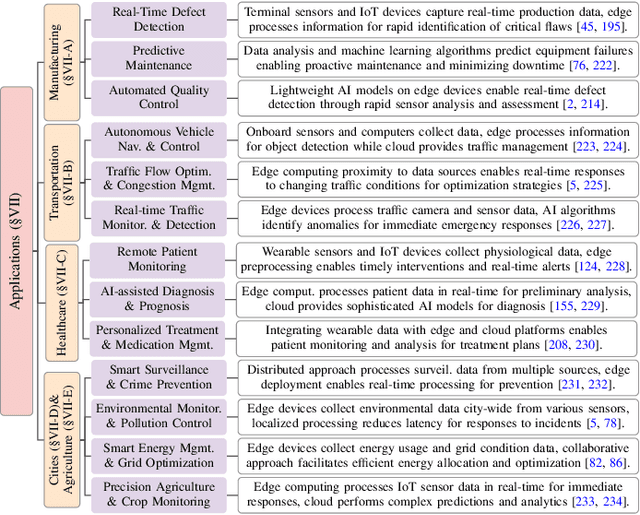
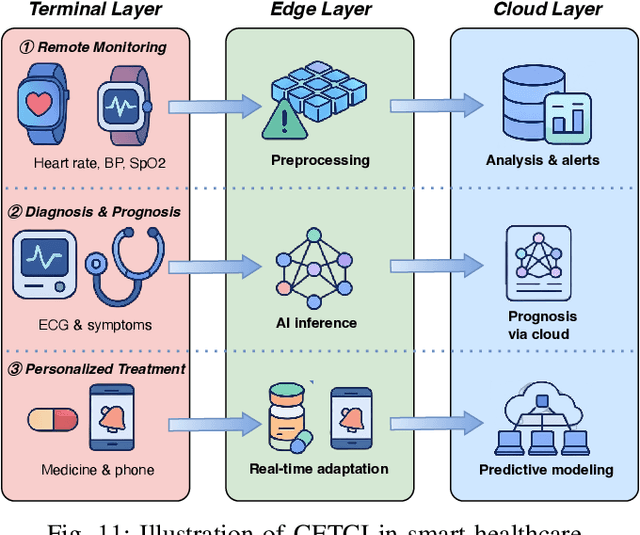
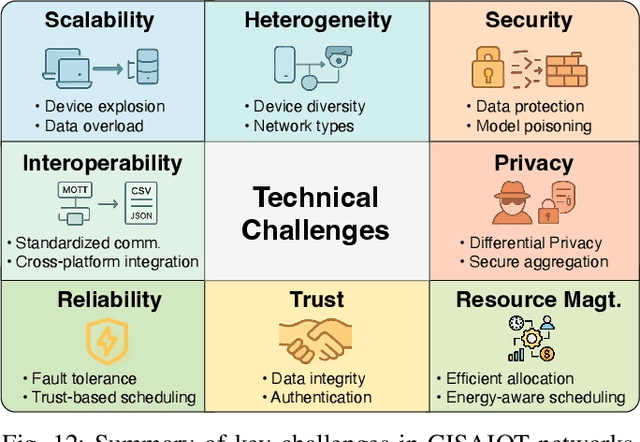
Abstract:The proliferation of Internet of things (IoT) devices in smart cities, transportation, healthcare, and industrial applications, coupled with the explosive growth of AI-driven services, has increased demands for efficient distributed computing architectures and networks, driving cloud-edge-terminal collaborative intelligence (CETCI) as a fundamental paradigm within the artificial intelligence of things (AIoT) community. With advancements in deep learning, large language models (LLMs), and edge computing, CETCI has made significant progress with emerging AIoT applications, moving beyond isolated layer optimization to deployable collaborative intelligence systems for AIoT (CISAIOT), a practical research focus in AI, distributed computing, and communications. This survey describes foundational architectures, enabling technologies, and scenarios of CETCI paradigms, offering a tutorial-style review for CISAIOT beginners. We systematically analyze architectural components spanning cloud, edge, and terminal layers, examining core technologies including network virtualization, container orchestration, and software-defined networking, while presenting categorizations of collaboration paradigms that cover task offloading, resource allocation, and optimization across heterogeneous infrastructures. Furthermore, we explain intelligent collaboration learning frameworks by reviewing advances in federated learning, distributed deep learning, edge-cloud model evolution, and reinforcement learning-based methods. Finally, we discuss challenges (e.g., scalability, heterogeneity, interoperability) and future trends (e.g., 6G+, agents, quantum computing, digital twin), highlighting how integration of distributed computing and communication can address open issues and guide development of robust, efficient, and secure collaborative AIoT systems.
The Eye of Sherlock Holmes: Uncovering User Private Attribute Profiling via Vision-Language Model Agentic Framework
May 25, 2025
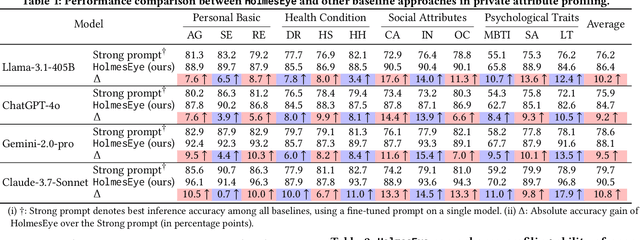


Abstract:Our research reveals a new privacy risk associated with the vision-language model (VLM) agentic framework: the ability to infer sensitive attributes (e.g., age and health information) and even abstract ones (e.g., personality and social traits) from a set of personal images, which we term "image private attribute profiling." This threat is particularly severe given that modern apps can easily access users' photo albums, and inference from image sets enables models to exploit inter-image relations for more sophisticated profiling. However, two main challenges hinder our understanding of how well VLMs can profile an individual from a few personal photos: (1) the lack of benchmark datasets with multi-image annotations for private attributes, and (2) the limited ability of current multimodal large language models (MLLMs) to infer abstract attributes from large image collections. In this work, we construct PAPI, the largest dataset for studying private attribute profiling in personal images, comprising 2,510 images from 251 individuals with 3,012 annotated privacy attributes. We also propose HolmesEye, a hybrid agentic framework that combines VLMs and LLMs to enhance privacy inference. HolmesEye uses VLMs to extract both intra-image and inter-image information and LLMs to guide the inference process as well as consolidate the results through forensic analysis, overcoming existing limitations in long-context visual reasoning. Experiments reveal that HolmesEye achieves a 10.8% improvement in average accuracy over state-of-the-art baselines and surpasses human-level performance by 15.0% in predicting abstract attributes. This work highlights the urgency of addressing privacy risks in image-based profiling and offers both a new dataset and an advanced framework to guide future research in this area.
Shallow Flow Matching for Coarse-to-Fine Text-to-Speech Synthesis
May 18, 2025Abstract:We propose a shallow flow matching (SFM) mechanism to enhance flow matching (FM)-based text-to-speech (TTS) models within a coarse-to-fine generation paradigm. SFM constructs intermediate states along the FM paths using coarse output representations. During training, we introduce an orthogonal projection method to adaptively determine the temporal position of these states, and apply a principled construction strategy based on a single-segment piecewise flow. The SFM inference starts from the intermediate state rather than pure noise and focuses computation on the latter stages of the FM paths. We integrate SFM into multiple TTS models with a lightweight SFM head. Experiments show that SFM consistently improves the naturalness of synthesized speech in both objective and subjective evaluations, while significantly reducing inference when using adaptive-step ODE solvers. Demo and codes are available at https://ydqmkkx.github.io/SFMDemo/.
Efficient Detection Framework Adaptation for Edge Computing: A Plug-and-play Neural Network Toolbox Enabling Edge Deployment
Dec 24, 2024Abstract:Edge computing has emerged as a key paradigm for deploying deep learning-based object detection in time-sensitive scenarios. However, existing edge detection methods face challenges: 1) difficulty balancing detection precision with lightweight models, 2) limited adaptability of generalized deployment designs, and 3) insufficient real-world validation. To address these issues, we propose the Edge Detection Toolbox (ED-TOOLBOX), which utilizes generalizable plug-and-play components to adapt object detection models for edge environments. Specifically, we introduce a lightweight Reparameterized Dynamic Convolutional Network (Rep-DConvNet) featuring weighted multi-shape convolutional branches to enhance detection performance. Additionally, we design a Sparse Cross-Attention (SC-A) network with a localized-mapping-assisted self-attention mechanism, enabling a well-crafted joint module for adaptive feature transfer. For real-world applications, we incorporate an Efficient Head into the YOLO framework to accelerate edge model optimization. To demonstrate practical impact, we identify a gap in helmet detection -- overlooking band fastening, a critical safety factor -- and create the Helmet Band Detection Dataset (HBDD). Using ED-TOOLBOX-optimized models, we address this real-world task. Extensive experiments validate the effectiveness of ED-TOOLBOX, with edge detection models outperforming six state-of-the-art methods in visual surveillance simulations, achieving real-time and accurate performance. These results highlight ED-TOOLBOX as a superior solution for edge object detection.
Practical Unlearning for Large Language Models
Jul 14, 2024



Abstract:While LLMs have demonstrated impressive performance across various domains and tasks, their security issues have become increasingly severe. Machine unlearning (MU) has emerged as a promising solution to address these issues by removing the influence of undesired data on the target model without compromising its utility in other aspects. MU typically assumes full access to the original training data to preserve utility, which is difficult to achieve in LLM unlearning. Existing LLM unlearning methods often assume access to data most affected by undesired data unlearning. However, this assumption underestimates the entanglement among various LLM capabilities and ignores data access limitations due to various issues. Moreover, these LLM unlearning methods do not sufficiently consider that unlearning requests in real-world scenarios are continuously emerging. To overcome these challenges and achieve practical LLM unlearning, we propose the O3 framework. The O3 framework includes an Out-Of-Distribution (OOD) detector to measure the similarity between input and unlearning data, and an Orthogonal low-rank adapter (LoRA) for continuously unlearning requested data. The OOD detector is trained with a novel contrastive entropy loss and utilizes a local-global layer-aggregated scoring mechanism. The orthogonal LoRA achieves parameter disentanglement among continual unlearning requests. During inference, our O3 framework can smartly decide whether and to what extent to load the unlearning LoRA based on the OOD detector's predictions. Notably, O3's effectiveness does not rely on any retained data. We conducted extensive experiments on O3 and state-of-the-art LLM unlearning methods across three tasks and seven datasets. The results indicate that O3 consistently achieves the best trade-off between unlearning effectiveness and utility preservation, especially when facing continuous unlearning requests.
Exploring Backdoor Attacks against Large Language Model-based Decision Making
May 27, 2024



Abstract:Large Language Models (LLMs) have shown significant promise in decision-making tasks when fine-tuned on specific applications, leveraging their inherent common sense and reasoning abilities learned from vast amounts of data. However, these systems are exposed to substantial safety and security risks during the fine-tuning phase. In this work, we propose the first comprehensive framework for Backdoor Attacks against LLM-enabled Decision-making systems (BALD), systematically exploring how such attacks can be introduced during the fine-tuning phase across various channels. Specifically, we propose three attack mechanisms and corresponding backdoor optimization methods to attack different components in the LLM-based decision-making pipeline: word injection, scenario manipulation, and knowledge injection. Word injection embeds trigger words directly into the query prompt. Scenario manipulation occurs in the physical environment, where a high-level backdoor semantic scenario triggers the attack. Knowledge injection conducts backdoor attacks on retrieval augmented generation (RAG)-based LLM systems, strategically injecting word triggers into poisoned knowledge while ensuring the information remains factually accurate for stealthiness. We conduct extensive experiments with three popular LLMs (GPT-3.5, LLaMA2, PaLM2), using two datasets (HighwayEnv, nuScenes), and demonstrate the effectiveness and stealthiness of our backdoor triggers and mechanisms. Finally, we critically assess the strengths and weaknesses of our proposed approaches, highlight the inherent vulnerabilities of LLMs in decision-making tasks, and evaluate potential defenses to safeguard LLM-based decision making systems.
Semantic Feature Learning for Universal Unsupervised Cross-Domain Retrieval
Mar 08, 2024



Abstract:Cross-domain retrieval (CDR), as a crucial tool for numerous technologies, is finding increasingly broad applications. However, existing efforts face several major issues, with the most critical being the need for accurate supervision, which often demands costly resources and efforts. Cutting-edge studies focus on achieving unsupervised CDR but typically assume that the category spaces across domains are identical, an assumption that is often unrealistic in real-world scenarios. This is because only through dedicated and comprehensive analysis can the category spaces of different domains be confirmed as identical, which contradicts the premise of unsupervised scenarios. Therefore, in this work, we introduce the problem of Universal Unsupervised Cross-Domain Retrieval (U^2CDR) for the first time and design a two-stage semantic feature learning framework to address it. In the first stage, a cross-domain unified prototypical structure is established under the guidance of an instance-prototype-mixed contrastive loss and a semantic-enhanced loss, to counteract category space differences. In the second stage, through a modified adversarial training mechanism, we ensure minimal changes for the established prototypical structure during domain alignment, enabling more accurate nearest-neighbor searching. Extensive experiments across multiple datasets and scenarios, including closet, partial, and open-set CDR, demonstrate that our approach significantly outperforms existing state-of-the-art CDR works and some potentially effective studies from other topics in solving U^2CDR challenges.
Phase-driven Domain Generalizable Learning for Nonstationary Time Series
Feb 05, 2024Abstract:Monitoring and recognizing patterns in continuous sensing data is crucial for many practical applications. These real-world time-series data are often nonstationary, characterized by varying statistical and spectral properties over time. This poses a significant challenge in developing learning models that can effectively generalize across different distributions. In this work, based on our observation that nonstationary statistics are intrinsically linked to the phase information, we propose a time-series learning framework, PhASER. It consists of three novel elements: 1) phase augmentation that diversifies non-stationarity while preserving discriminatory semantics, 2) separate feature encoding by viewing time-varying magnitude and phase as independent modalities, and 3) feature broadcasting by incorporating phase with a novel residual connection for inherent regularization to enhance distribution invariant learning. Upon extensive evaluation on 5 datasets from human activity recognition, sleep-stage classification, and gesture recognition against 10 state-of-the-art baseline methods, we demonstrate that PhASER consistently outperforms the best baselines by an average of 5% and up to 13% in some cases. Moreover, PhASER's principles can be applied broadly to boost the generalization ability of existing time series classification models.
Federated Learning with New Knowledge: Fundamentals, Advances, and Futures
Feb 03, 2024Abstract:Federated Learning (FL) is a privacy-preserving distributed learning approach that is rapidly developing in an era where privacy protection is increasingly valued. It is this rapid development trend, along with the continuous emergence of new demands for FL in the real world, that prompts us to focus on a very important problem: Federated Learning with New Knowledge. The primary challenge here is to effectively incorporate various new knowledge into existing FL systems and evolve these systems to reduce costs, extend their lifespan, and facilitate sustainable development. In this paper, we systematically define the main sources of new knowledge in FL, including new features, tasks, models, and algorithms. For each source, we thoroughly analyze and discuss how to incorporate new knowledge into existing FL systems and examine the impact of the form and timing of new knowledge arrival on the incorporation process. Furthermore, we comprehensively discuss the potential future directions for FL with new knowledge, considering a variety of factors such as scenario setups, efficiency, and security. There is also a continuously updating repository for this topic: https://github.com/conditionWang/FLNK.
 Add to Chrome
Add to Chrome Add to Firefox
Add to Firefox Add to Edge
Add to Edge